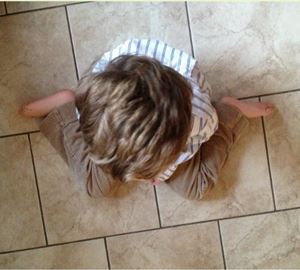Physical Therapy Corner: What's Wrong with W-Sitting?
[Source: The Inspired Treehouse.com]
 I thought it would be appropriate during our snow theme to address an everyday issue that I come across as a pediatric physical therapist in a preschool setting. Each time I walk into a classroom, I can find at least 3 children who are on the floor in the W-Sitting position…and they kind of remind me of melting snowman. Their legs are wide around their bottoms, their trunk posture is often droopy and they aren’t able to move their arms outside of their base of support to play. I am constantly saying “fix your legs” or “NO “W” SITTING!”. What’s so wrong with W-sitting? Let’s explore.
I thought it would be appropriate during our snow theme to address an everyday issue that I come across as a pediatric physical therapist in a preschool setting. Each time I walk into a classroom, I can find at least 3 children who are on the floor in the W-Sitting position…and they kind of remind me of melting snowman. Their legs are wide around their bottoms, their trunk posture is often droopy and they aren’t able to move their arms outside of their base of support to play. I am constantly saying “fix your legs” or “NO “W” SITTING!”. What’s so wrong with W-sitting? Let’s explore.
W-sitting looks like this: a child sits on the floor, their bottoms are between their legs, and their knees are bent with their legs rotated away from the body – if you stand above them and look down, it looks like their legs are forming a “W”. All children have the potential to begin the W-sitting habit. In this position, kids’ base of support is wider and their center of gravity is lower allowing for increased stability through their hips and trunk. It’s a convenient position for play because they do not have to work on keeping their balance while also concentrating on toys.
W-sitting is problematic for the following reasons:
-In this position, a child cannot achieve active trunk rotation and cannot shift their weight over each side making it difficult to reach toys that are outside their immediate reach. It is so important for kids to be able to weightshift and rotate in order to develop adequate balance reactions (think of the ability to catch their fall when they are running) and for developing the ability to cross midline (very important for writing). Bilateral coordination (the ability to effectively use both sides of the body together) is delayed as a result. Every motor skill a child develops is a product of developing the milestone before. So, if a child has difficulty developing bilateral coordination, he may then demonstrate delays in skills such as developing hand dominance, skipping, throwing, kicking, etc.
PediaStaff is Hiring!
All JobsPediaStaff hires pediatric and school-based professionals nationwide for contract assignments of 2 to 12 months. We also help clinics, hospitals, schools, and home health agencies to find and hire these professionals directly. We work with Speech-Language Pathologists, Occupational and Physical Therapists, School Psychologists, and others in pediatric therapy and education.
